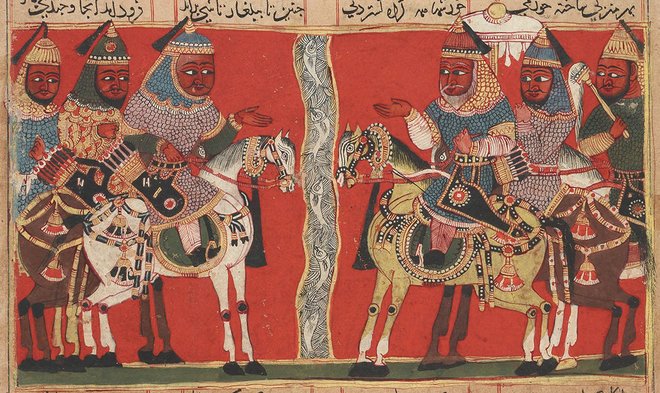
Historically, the Bashkir people numbered more than 40 territorial clan divisions (clan uluses). According to the sherjere legends, members of each clan ascend to a single ancestor. A Russian lexicographer Vladimir Dahl wrote: “From the time immemorial, the people of Bashkurt have been split into tribes or, as we call them, into uluses; each ulus has its own uran, response, tamga, its own tree and bird, as reportedly assigned by Chingiz Khan himself...”. One of the largest clans was Kangly, it gave the name to the Kanlin ulus. It covered the entire territory of the modern Buzdyak district and parts of the Beleb, Blagovar, Birsk, Dürtül, Kushnarenk, Mishkin and Tuimazyin districts of the Bashkortostan Republic.
"Most Holy Kangha"
Each Bashkir clan has is its own history behind its name, which often ascends few centuries into the past. One of the champions in this respect is clan Kangly. Their ethnonym can be traced to the Mesopotamia's Assyrians in Sumer in the Assyrian tablets ca 2200 BC, then to the epic tales of the ancient Aryans as Turan inhabitants. The Avesta tells how the prophet Zarathushtra gave the following prayer to the water goddess Ardvi-Sure Anahita (where the goddess name carries a suspiciously Türkic flavor: ar man, soldier; su water; ana mother; and modifiers -dvi/-re/-hita are suffixed to the roots):
So give me luck, good Ardvi-Sura,
To strike Turan warriors by hundreds...
With fifty blows in the most holy Kangh.
According to the researchers, Kangha is the area connected with the name Kangly. It's difficult to say to what specific time period refers the above verse. It is believed that Avesta was first recorded by the 6th c. BC legendary prince Vishtaspa of the Achaemenid clan. However, since Avesta was oral for many centuries, the dating of the ancient Iranian epic is a poor base for the dating of the name Kangh. Avesta priests were narrating it from generation to generation. Therefore, there is reason to believe that the “Most Holy Kangha” already existed in the 2nd mill. BC, that is, before disintegration of a unified Aryan community into Iranians and Indo-Aryans, which (speculatively) occurred in Central Asia after the departure of the Aryans from Arkaim, Sintashta and other settlements of the “city of cities” (actually, from the 2nd mill. BC Eastern Europe, and unrelated to the nomadic centers “Arkaim, Sintashta and other settlements”).
(ju Chinese for “tribe”, Kangju is shown in the Aral-Balkhash interfluvial,
map dating is ca 1st c. AD)
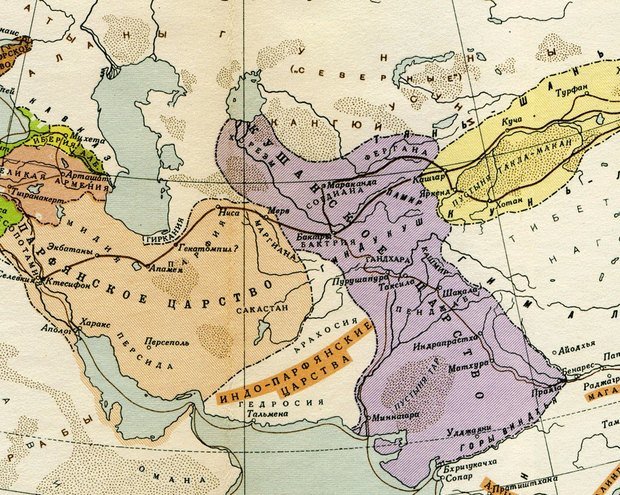
Ancient Turan
After the Aryans moved to the Middle East, they called the country Ariana, i.e. “Aryan country” or Iran (from Türkic ar “man, warrior”, with abstract suffix -an. The name does not have an IE etymology. Semantically, the Aryan of Vedas is opposite of “captured, slaves”, i.e. it is “free, unrestrained, pure”, Cf. Türkic arïɣ “pure, noble, most holy”, Cf. “arms, army, aristocracy”. In a largely sedentary farming society of class castes, Aryans were the rulers, the rest were chattel of various grades). However, a significant part of their former compatriots stayed in their homeland and continued to wander in the steppes of Eurasia. Avesta called them Turanians, and their country - Turan. The confrontation between (the sedentary farming) Iran and (nomadic pastoralist) Turan is the central plot of the poem “Shahnameh” by the 11th c. Persian poet Abu-al-Qasim Firdosui. The poem is based on Arabic translation of the Sassanid empire's official epic “Khwaday-Namag” (Cf. Türko-Persian Hudai “Lord”, a Persian equivalent for the Aryan; Namag stands for “book”), which in turn is a version of the Avesta storyline. In one place the poem relays how the Turanian king Afrasiab meets the Iranian prince Siyavush:
Setting off, they continued to march,
Tirelessly rushing forward.
And soon reached happily
The blooming Kang - a capital of the world.
According to the poem, Kang was the capital of the legendary Turan. The very area of Kang or Kangar, according to scientists, was located in the middle course of the Syr Darya river. According to S.G. Klyashtorny, ethnonym Kangar consists of the root Kang and the Tocharian (unspecified Agni, Agnean (mislabeled Tocharian A) or Kucha, Kuchean (mislabeled Tocharian B) ethnonymic suffix -ar- (Türkic standard suffix -ar-, morphologically used in Agnean and Kuchean languages, and languages across Eurasia, Cf. Balkar, Bulgar, Khazar, Tatar, boyar, teacher, maker, inspector, etc.).
Kangar State
The Kangar state emerged (or rather came to the attention of the Chinese chroniclers) in the 2nd century BC. It covered a huge territory: from the lake Balkhash in the east to the Caspian Sea in the west, and from the Amu Darya in the south to the Southern Urals in the north. The state was noted by the surrounding countries. The Chinese chronicle “Qian Han-shu” (rather, “Shi ji” (“Historical notes”) by Sima Qian (ca.145 or 135-86 BC), an ancient Chinese historian, the author of the first historical summary of China) reports that its population consisted of 120 thousand families with 600 thousand souls. The army was 120 thousand people (entire adult male population). Kangar (in Chinese, Kangüy) was allied with the Huns. By antiquity standards, it was a major power with about 4 thousand kilometers circumference with the population comparable to the largest states of the time (China, for comparison, had 50 mln population. Huns numbered 3 mln population, compatible with a single Chinese province, while Chinese territory was compatible with that of Kangar and miniscule compatible with the Hunnic territory).
During a supreme period of its might, the Han Empire subjugated all neighboring countries, including (fractions of the) Hunnic state (Reference to the Türko-Chinese Tang Empire expansion 650-751). Only Kangar refused to submit. The Chinese chroniclers lamented: “Kangju, on the contrary, is proud, bold and does not agree to honor our envoys. It sits officials sent to him by the (Chinese) viceroy below the Usun envoys”.
| Kangar Confederation ca. 659-750 |
|---|
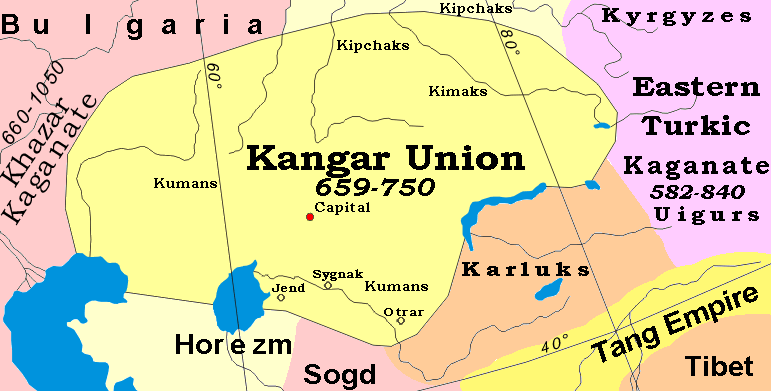 |
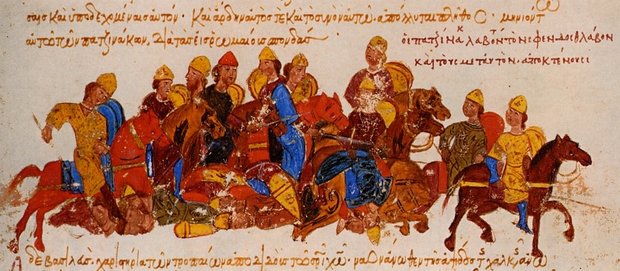
Pechenegs
(The eastward and westward Kurgan nomadic waves are detectable as early as ca. 9th mill. BC (R1a) and ca. 6th mill. BC (R1b). Any proclamations about languages for those times are declarations of utter nonsense, albeit that happens routinely in some eager corners. Reverse extrapolation leads exclusively to an undifferentiated Türkic family. The westward haplogroup R1a reached Europe's Balkans by a southern route via Anatolia. The haplogroup R1b reached Central Europe by repeated overland waves from their Khvalynsk and Samara centers, and by circum-Mediterranean route from the Pontic steppes to Iberia as Celtic Kurgans of the 4000-2800 BC. The remaining mass of the R1a and R1b Kurgan components stayed in the Central Asia with overland prongs extending in all directions. The oldest clades of these haplogroups are found in the environs of the Central Asia. Obviously, only the attainment of a horse as a means of transportation allowed cross-continental migrations in demographically sufficient mass. All overland migrations were reciprocative movements, the R1a Balkan and R1b Celtic incursions remained one-way, with the Celtic migration reaching Balkans and Anatolia in its westward spurs. Reciprocative movements are innate to the pastoral economy, they are real waves that come and go. A sedentary eye, however, does not see waves, it focuses on impact of the coming action. A distinction of the nomadic states was that all of them were tribal unions, since all tribes were mobile and were held together by voluntary confederation.)
In the 6th c. Türkic tribes poured into the steppes of Central Asia (this is absurd nonsense, the pastoral Türkic Kurgans never left Central Asia). They joined Kangars, creating a new tribal union called Kangar Union, (due to demographical prevalence, in the west) it was called Bajanak, that is “in-laws”. In the Rus sources, they are known as Pechenegs. In the ancient Orkhon Türkic inscriptions they were called Kengeres (with Türkic animated instrumental suffix -er and plural suffix -s/-es).
Formerly Iranian-speaking Kangars soon switched to Türkic.
There is absolutely no indications that Kangars ever spoke Iranian. just the opposite, they could not have learned Iranian before the Iranian was created. It was created on the Iranian Plateau after the refugees from the Eastern Europe with some Eastern European language came there into the Dravidian and Türkic lands sometime at 1500 BC. What happened to the migrants in the first 900 years is a complete blank, neither Aryans nor Iranians existed for history. As Persians, the refugees come to light after a palace coup against the ruling Medes. They adopted the local version of the agglutinative Dravidian language, sprinkling it with specs of their former European and local Sumerian and Assyrian languages, and who knows what else. The initial form of the amalgamated language is now called Old Persian, it is an agglutinative language with local non-IE morphology and grammar. It is incomprehensible with the later versions of the Middle and New Persian, which each absorbed very different inputs of lexis, morphology and grammar. The Kangars, in contrast, were local, known from the Assyrian inscriptions ca 2200 BC, or 700 years before the arrival there of the Indo-Aryan migrants. Most likely, they were southwestern spurs of the tribes later known as Türkic Kangars and Kangly. The Medes likely belonged to the same Türkic phylum as the Kangars, Kangly, and Guties.
The Byzantine emperor Constantine VII the Porphyrogenitus (905–959) wrote: “It should be known that the Pachinakites are also called Kangar, however not all, but the people of three themes: Iavdiirti, Kuartsitsur and Khavuksingila, as more courageous and noble than others, since this is the meaning of name Kangar”.
At the end of the 9th c., a large-scale war between two coalitions of Türkic peoples broke out in the territory of the modern Kazakhstan: Bajanaks and Bashkirs on one side and Khazars, Oguzes, Kimaks, and Karluks - on the other. The first succumbed to a powerful group and were defeated. Fleeing from the enemy, they moved westward, crushing everything in their path. The Bajanaks and Bashkirs plundered the Khazar Kaganate, drove the (Ugric) Hungarians-Magyars from the Black Sea to the Central Europe, and attacked the (incipient) Rus. For 150 years the Bajanaks and their allies threatened Rus and were a curse for the Byzantine Empire.
The 10th c. Arab historian al-Mas'udi wrote: “And these tribes of Bajanak, Yajna, Bashkurd and Naukerd spread their tents, blocking the path between Constantinople and Rome (i.e. Kangars controlled the Balkans). And they ruined most of the localities, and their raids spread to Constantinople itself ”.
Kangly
Not all Bajanaks and Bashkirs moved to the west. A small part of them remained in their places and joined or allied with the mighty Oguzes. This story is recorded in the Oguz epic “Oguz-name”: “As for the country Kural and Bashgurd, its inhabitants were recalcitrant and insidious people. In their arrogance and pride, they did not bow to any ruler. Then Oguz captured their padishah Karashit. After that, Kural and Bashgurd became an il (land, province) and agreed to pay tribute.” (Inaccurate translation. Türkic members of Türkic confederations do not pay tribute, as do the sedentary subjects, their obligation is to supply military contribution.)
Under Oguz pressure, Bashkirs shifted northward, and the Bajanaks remained close by in the territory of modern Kazakhstan Aktüba province. The first and the second described Ibn Fadlan (10th c.) in his report about the passing through their lands.
The demographic influence of the Indo-Aryan migrants, likely composed of genetically diverse castes, on the native populations of the Iranian Plateau, must have been negligible. The haplogroup G1-M285 is guesstimated to evolve 8 to 10 millenniums ago, while the Indo-Aryans migrated to the Iranian Plateau 3.5 mill. ago, or 4.5 to 6.5 millenniums later. Thus, the male Kangars carry genetic marker of the previous, Dravidian populace. Manipulating the anachronistic data as an ethnic argument is a preposterous propagandistic disinformation. Fascinating is the presence of the most southern G1-M285 in the most northern Karelia. The highest concentration of G1 within a distinct group was reported among the Madjars of Kazakhstan (87% of 45 samples) and Argyns (67%). The Madjars of Kazakhstan are erroneously speculated to be related to the Ugro-Fennic Hungarian Magyars, today Madjars are a member of a large tribe Argyn of the Kazakhstan Middle Juz that coagulated in the 8th-9th cc. from the Kazakhstan fractions of the Enisei Kirgizes and their allies. There is no trace of any Indo-Aryans among those Türkic tribes. Note that in the math mirror, the educated guesstimate of 8 to 10 millenniums ago turns into 24,500 years ago, because the haplogroup G1-M285 (=M342) arose 170 snips ago, and the snips on average occur every 144 years. The older origin of the G1-M285, however, does not change the relative dating of the very recent Indo-Aryan migration to the South-central Asia.
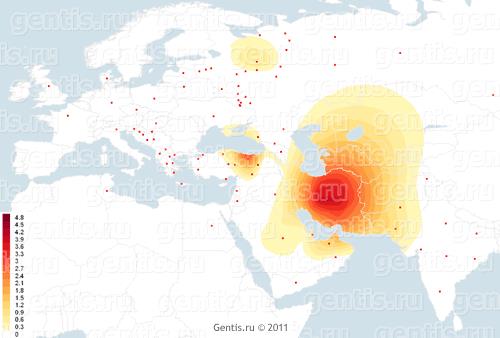
Interestingly, the so-called Bajanaks carried to their former name. A 12th c. Arabian geographer called them Hangakishi (Kang + kishi “people”), i.e. “Kang people”. And Kipchaks from the east called them Kangar-oglï “Kangar children”. A 14th c. Egyptian encyclopedist Shihab al-din al-Nuvayri named the following tribes of the Kypchaks: Tuksaba, Yete (Ete-oba), Burj-Ogly, Alburly, Kangar-Ogly, Andj-Ogly, Durt, Kulaba-Ogly, Djuznan (Djurtan), Karaburekli (“Black Hoods” of the Rus chronicles), Kotan.
Over time, the ethnonym Kangar-Ogly transformed into contracted form Kangly. Under this name they entered a clan structure of many nations, first of all the Bashkirs, and later Kazakhs, Uzbeks, Nogais, Karakalpaks and others. In Bashkiria, they formed the Kanlin ulus. (Since Kangly/Bajanaks reached Adriatic and settled in the Balkans, first of all they entered the Balkans' clan structures, and their genes should be sought in Bosnia and its environs.)
In 2012 several dozen samples of Bashkir Kanglins genetic material were collected during a joint expedition of the Medical-Genetic Research Center of the Russian Academy of Medical Sciences and the Institute of Humanitarian Studies. The main portion of the surveyed were the people of the villages in the Buzdyak district of the Bashkortostan Republic. For the Kangly clans a haplogroup G1-M285 was found to be principal, its maximums are in the territory of the modern Iran.
This may substantiate the historians' suspicion of the ancient Iranian origin of the Kanlin people. (Actually, since the “Iranian” is a cultural (i.e. linguistic) and not a genetic trait, it links Kangars with the original inhabitants of the plateau, not with political and cultural influence of the latecomers. The tendentious misinformation of a biased interpretation has nothing to do with the genetics.)
Bashkirs of the Kangly clan
The Bashkir clan Kangly gave Bashkortostan many prominent people. Among them are the head of the Kanlin ulus and the Pugachev's colonel Miney Sultukov (Sultuk) from the village Sabaevo in the current Buzdyak district of the Bashkir Republic (Pugachev was a leader of a popular revolt against the Russian oppression in 1773-75). First, he ravaged the estate of Tevkel Murzas (nobility), who seized the lands of the Kanlin ulus' Bashkirs. Then he led a rebel vanguard under a command of a Burzyansk ulus centurion and a chief colonel Karanai Muratov. In December 1773, Miney with his detachment of Bashkir Kanlins occupied a village Kasevo (now the city Neftekamsk) and sent his people to Sarapul to have the local peasants pledge an oath to the “emperor Peter Fedorovich”, and then along with Karanai Muratov he laid a siege of Menzelinsk settlement. Until the spring of 1774 Miney Sultukov acted near Sarapul, fighting near a Kambar plant together with ataman (chieftain) Peter Vyazov against detachments of the Sarapul militia and a colonel of the Archangelgorod's carbineer regiment under A.F. Obernibesov. He fought government forces during the entire summer and autumn of 1774.family
In the 19th c. a noble clan of Syrtlanovs, whose members held various posts in the Bashkir army, was a most famous family of the Kanlin's Bashkirs. Being an elite of the Bashkir society, they were at the birth of the Bashkir national movement. So, Shah-Aidar Syrtlanov (1847–1916), born in the Shlanlykulevo village, nowadays in the Buzdyak district of the Bashkir Republic, was a great-grandson of the Kanlin's ulus Bashkir patrimony-holder Syrtlan Aitkulov and a son of a esaul (cavalry captain) Shagimardan Syrtlanov, a head of the 12th canton of the Bashkir army. An active member of the Muslim movement, Shah-Aidar Syrtlanov was one of the organizers and leaders of the “Ittifak al-muslimin” (“Union of Muslims”) and its three congresses (1906), and then was elected a representative from Ufa province to the Russian Empire State Duma of the 1st and 2nd convocations. The plunder of the Bashkir land was a common theme of his service.
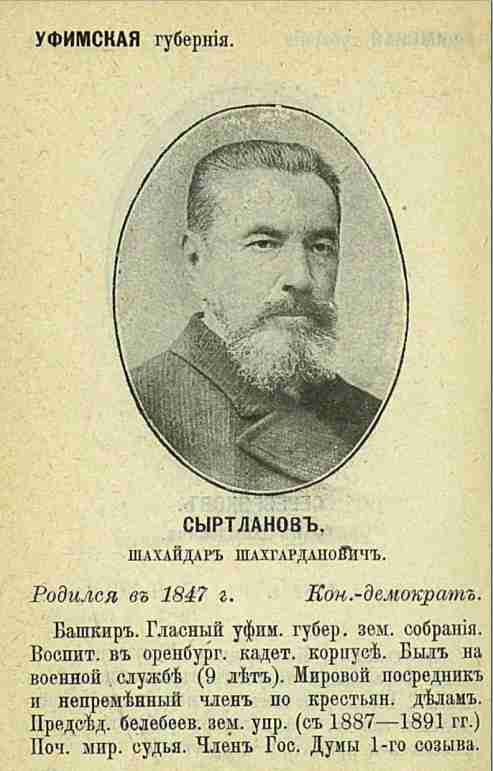
“I am a representative of the Ufa province, elected by indigenous population, the Bashkirs”, said the deputy at a Duma meeting on June 2, 1906, - “Bashkirs accepted allegiance over 400 years ago, they are not a conquered people. At acceptance of allegiance, they were promised that neither their land, property, religion, customs, nor life will be affected”.
According to Sh. Syrtlanov, the Russian government did not keep its promises.
His son Ali-Askar Syrtlanov (1875–1912) served in the Life Guardian Lithuanian regiment, and after retirement became a famous St. Petersburg lawyer. For example, he was a defender in the case of Admiral Rojdestvensky and General Stoessel, indicted for a defeat in the Russian-Japanese war. Ali-Askar Syrtlanov was one of the first Muslim intelligentsia of the Russian empire who advocated a right of the eastern peoples for a territorial autonomy during the First Russian revolution of 1905-1907. Notably, A.-Z. Validi purported Ali-Askar to the leadership of the Bashkir national movement till his absurd death in 1912.
Another son of Shah-Aidar Syrtlanov, a Colonel Ravil Syrtlanov, fell a heroical death in the Baranovichi operation on June 20, 1916, he was posthumously advanced to a major general and awarded an Order of St. George. Another of the Syrtlanovs, a Senior Sergeant Mullayar Syrtlanov, in 1943 was bestowed a title Hero of the Soviet Union.
Some of the leaders of the Bashkir national movement, which began after the February Revolution of 1917, were members of the Kangly clan Sheikhzada Babich (1895-1919) and Mullaian Khalikov (1894-1937).
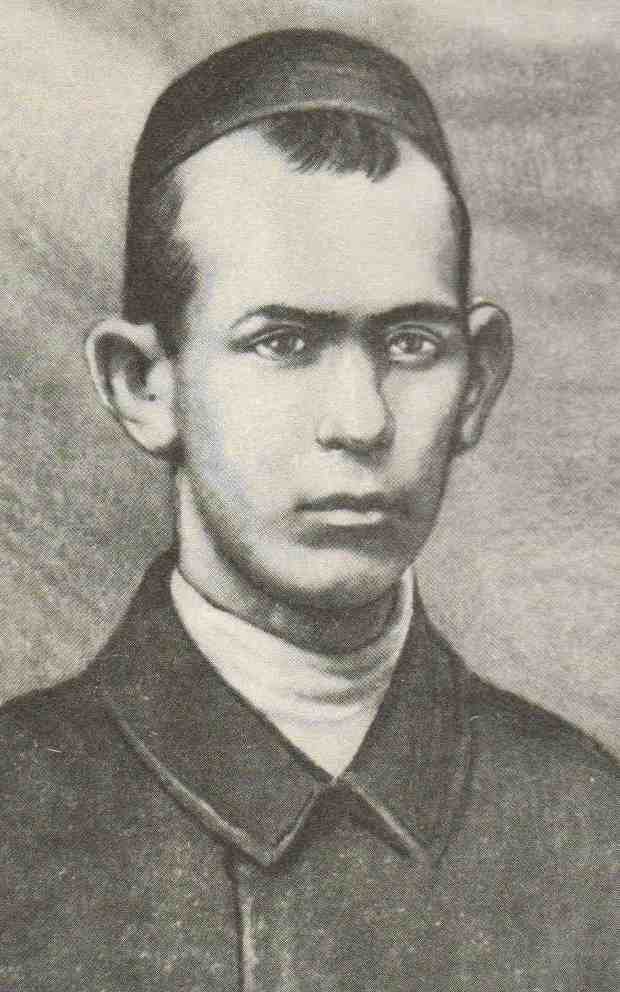
Sheikhzada Babich came from aul Kigazytamak of the present Mishkinsky district of Bashkir Republic. He was a famous poet, “a singer of the Bashkir revolution”, secretary of the Bashkir National Council (Shuro), editor of the newspaper “Bashkort”, and a head of the youth organization “Tulkyn” (“Wave”). During a switch of the Bashkir troops to the Red Army side, Sheikhzad Babich was brutally killed in the village Zilair by the Red Army soldiers. He signed his early poems with an alias “Kangly Balasy” (“A Son of Kanlin”), and was a most prominent expression of the Bashkir identity:
We are Bashkirs. We are
Bequeathed a clan title “bash” (head, leader)
Our topazes and diamonds
Match our gardens and fruits.
Mullaian Khalikov was born in the village of Aktau of the present Buzdyak district of Bashkir Republic. He served in the government of the “autonomous Bashkurdistan”, on its behalf he established contacts with Samara Komuch (an alternate Russian constituent assembly and government), and on March 20, 1919, he was one of the signatories of the “Agreement” with the central Soviet authorities on the Soviet autonomy of Bashkiria. In 1919-1920, Mullayan Khalikov was a member of the leadership of Bashrevkom (Bashkirian Revolutionary Committee, a local executive apparatus with legislative powers). In 1921-1925, he was a chairman of the Council of People's Commissars of the BASSR (Bashkir Autonomous Soviet Socialist Republic).
In 1957, the relay of the top leaders of the Bashkortostan again passed to a member of the Kangly clan in a person of Ziya Nurievich Nuriyev (1915 – 2012), a native of the village of Verkhnelachentau of the present Birsk district of the Bashkir Republic. In 1957–1969 he served as the 1st secretary of the Bashkir regional committee of the CPSU (USSR Communist Party). Under him, the Bashkir ASSR achieved tremendous success in socio-economic development. In 1973-1985 Ziya Nuriyev was a deputy chairman of the USSR Council of Ministers.
Many prominent creative intelligentsia members come from the Bashkirs of the Kangly family. Among them are the writers Ali Karnay, who was an editor-in-chief of the newspaper Kyzyl Atlilar (Red Horsemen) of the 112th Bashkir Cavalry Division, and Hakim Gilyajev, Fakikha Tuguzbaev, and a playwright Florid Bulyakov. National artists of the Bashkir Republic and the Russian Federation Tansulpan Babichev and Fidan Gafarov also belong to the Kangly clans.
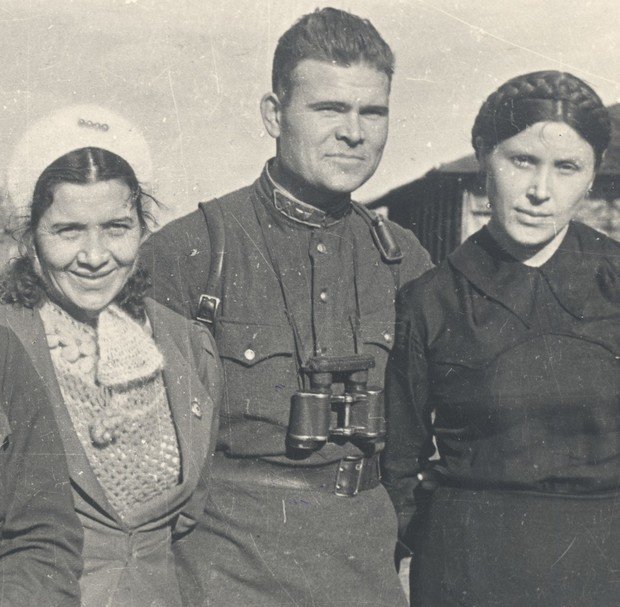
Salavat Ishmuhametovich Khamidullin - historian, Ph.D., journalist.
Born in the city of Sterlitamak in 1968.
Education: Bashkir State University (Faculty of History).
1990-1991 - correspondent of the newspaper “Istoki".
1991-1995 - editor of the youth edition of the Republican TV, head of the creative association “Molodost".
Since 1995 - a correspondent for the program “Bashkortostan", the editor of the TO “Gilom", the TO
of social and political programs, the head of the department of educational and historical programs,
the head of the editorial board of the educational programs of the BST studio.
Author and TV presenter of TV projects “Historical environment” and “Clio”.
Author of a number of documentaries, books and scientific publications on the history of
Bashkortostan and Bashkir clans. Columnist of “Real time".
Laureate of the State Prize of Bashkir Republic. S. Yulaev, Sh. Hudayberdin Republican Prize
in Journalism. Winner of international and republican television festivals.